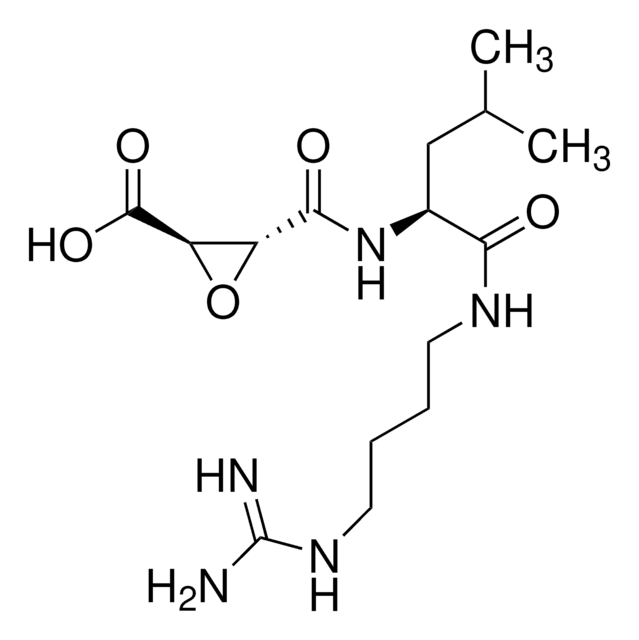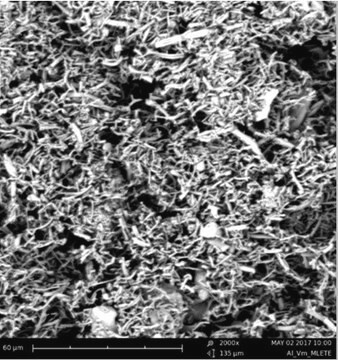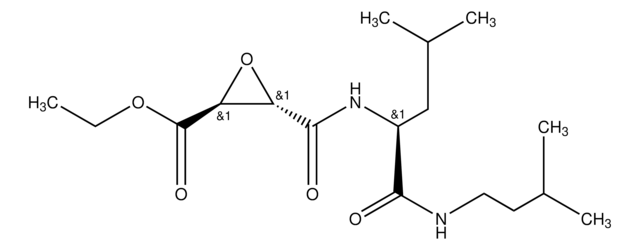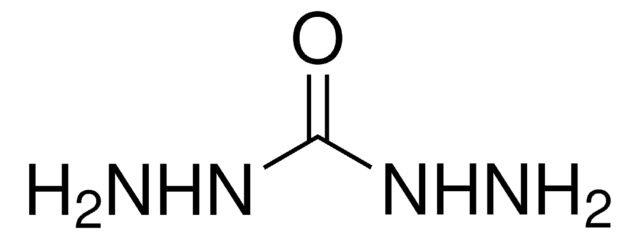E64-RO
Roche
E-64
N-[N-(L-3-Trans-carboxirane-2-carbonyl)-L-leucyl]-agmatine
Synonym(s):
E-64, n-[n-( l-transepoxysuccinic acid)-l-leucyl]-agmatine, n-[n-(l-3-trans-carboxirane-2-carbonyl)-l-leucyl]-4-aminobutylguanidine, n-[n-(l-3-trans-carboxirane-2-carbonyl)-l-leucyl]-agmatine.
note: another name for l-3-trans-carboxyoxiran-2-carboxylic acid acid is l-transepoxysuccinic acid. agmatine is 4-aminobutylguanidine., trans-Epoxysuccinyl-L-leucylamido(4-guanidino)butane, L-trans-3-Carboxyoxiran-2-carbonyl-L-leucylagmatine, N-(trans-Epoxysuccinyl)-L-leucine 4-guanidinobutylamide
About This Item
Recommended Products
Quality Level
assay
>95% (HPLC)
form
powder
mol wt
Mr 357.4
packaging
pkg of 10 mg (10874523001)
pkg of 25 mg (11585681001)
manufacturer/tradename
Roche
pH range
2-10
solubility
ethanol: water (1:1): soluble 20 mg/mL
storage temp.
2-8°C
SMILES string
CC(C)C[C@H](NC(=O)[C@@H]1O[C@H]1C(O)=O)C(=O)NCCCCNC(N)=N
InChI
1S/C15H27N5O5/c1-8(2)7-9(20-13(22)10-11(25-10)14(23)24)12(21)18-5-3-4-6-19-15(16)17/h8-11H,3-7H2,1-2H3,(H,18,21)(H,20,22)(H,23,24)(H4,16,17,19)/t9-,10+,11+/m0/s1
InChI key
LTLYEAJONXGNFG-HBNTYKKESA-N
Looking for similar products? Visit Product Comparison Guide
Related Categories
Specificity
Application
It has been used in the affinity chromatography for the purification of hemoglobin receptors.
The inhibition of thiol proteases by E-64 appears to be of a non-competitive nature between the SH components. The inhibition is also irreversible, and is altered after gel filtration (Sephadex column) or dialysis after incubation of papain with E-64. The enzyme and inhibitor combine in an equimolar ratio.
Biochem/physiol Actions
Preparation Note
Working solution: Soluble to 20 mg/ml (stock solution) in a 1:1 (v/v) mixture of ethanol and water (vortexing or slight warming in water bath (40 °C) may facilitate dissolution). Also soluble in a neutral water/methanol solution, in water, methanol, acetic acid, pyridine and DMSO. Sparingly soluble in ethanol and propanol. Insoluble in acetone, chloroform, ethyl ether and benzene.
Storage conditions (working solution): -15 to -25 °C
Solutions are stable for one month when stored in aliquots at -15 to -25 °C.
Reconstitution
Other Notes
signalword
Warning
hcodes
Hazard Classifications
STOT SE 2
Storage Class
11 - Combustible Solids
wgk_germany
WGK 2
flash_point_f
does not flash
flash_point_c
does not flash
Choose from one of the most recent versions:
Already Own This Product?
Find documentation for the products that you have recently purchased in the Document Library.
Our team of scientists has experience in all areas of research including Life Science, Material Science, Chemical Synthesis, Chromatography, Analytical and many others.
Contact Technical Service








